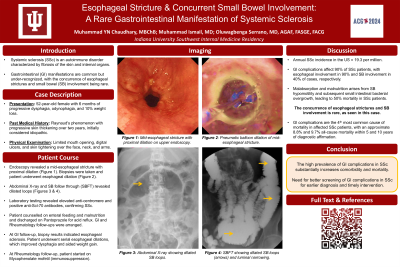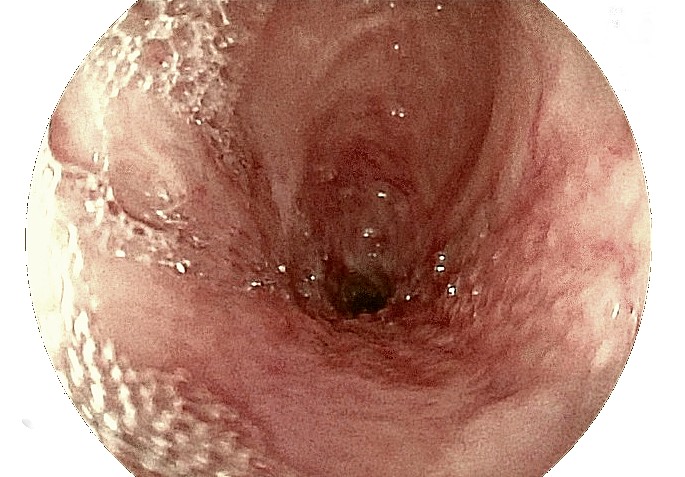Tuesday Poster Session
Category: General Endoscopy
P4153 - A Rare Case of Gastrointestinal Manifestations of Systemic Sclerosis: Esophageal Stricture With Concurrent Small Bowel Involvement
Tuesday, October 29, 2024
10:30 AM - 4:00 PM ET
Location: Exhibit Hall E

Has Audio

Muhammad YN Chaudhary, MBChB
Indiana University Southwest
Evansville, IN
Presenting Author(s)
Muhammad YN. Chaudhary, MBChB1, Muhammad Ismail, MD2, Oluwagbenga Serrano, MD, FACG3
1Indiana University Southwest, Evansville, IN; 2Indiana University Southwest, Cedar Rapids, IA; 3Good Samaritan Hospital, Vincennes, IN
Introduction: Systemic sclerosis (SSc) is an autoimmune disorder characterized by fibrosis of the skin and internal organs. Gastrointestinal (GI) involvement is common but often under-recognized. This case report presents a novel instance of SSc with severe esophageal stricture and concurrent small bowel involvement, emphasizing diagnostic challenges and management strategies.
Case Description/Methods: A 52-year-old female presented with six months of progressive dysphagia, odynophagia, and a 10% weight loss. Her medical history included Raynaud's phenomenon and progressive skin thickening over two years, initially considered idiopathic. Physical examination revealed limited mouth opening, digital ulcers, and skin tightening over the face, neck, and arms.
Upper endoscopy showed a severe mid-esophageal stricture with proximal dilation (Image 1). Biopsies indicated esophageal sclerosis. A SB follow-through showed dilated, tortuous loops with luminal narrowing and mucosal irregularities. Laboratory tests showed elevated anti-centromere and positive anti-Scl-70 antibodies, confirming SSc. Pulmonary function tests (PFTs) indicated restrictive lung disease, and high-resolution computed tomography (HRCT) revealed interstitial lung disease with fibrosis.
The patient was started on pantoprazole for acid reflux and underwent serial esophageal dilations to maintain esophageal patency. She received nutritional counseling and enteral feeds to address malnutrition. Immunosuppressive therapy with mycophenolate mofetil was initiated in consultation with rheumatology. Follow-up showed improvement in dysphagia and weight gain.
Discussion: It is hypothesized that esophageal strictures arise as a result of esophageal dysmotility causing stasis. Atrophy of the esophageal smooth muscles, including the lower esophageal sphincter, ensues, resulting in acid reflux. The concurrence of esophageal strictures and SB involvement is rare. This case highlights the complexity of diagnosing and managing GI manifestations of SSc, particularly with the involvement of multiple organ systems.
Serial esophageal dilations are often required to maintain luminal patency, as seen in our patient. SB involvement can lead to malabsorption and malnutrition, requiring enteral nutrition support. Immunosuppressive therapy, like mycophenolate mofetil, is critical in managing systemic symptoms and slowing disease progression. Regular follow-up with PFTs and HRCT is essential for monitoring ILD, a common complication in SSc.

Disclosures:
Muhammad YN. Chaudhary, MBChB1, Muhammad Ismail, MD2, Oluwagbenga Serrano, MD, FACG3. P4153 - A Rare Case of Gastrointestinal Manifestations of Systemic Sclerosis: Esophageal Stricture With Concurrent Small Bowel Involvement, ACG 2024 Annual Scientific Meeting Abstracts. Philadelphia, PA: American College of Gastroenterology.
1Indiana University Southwest, Evansville, IN; 2Indiana University Southwest, Cedar Rapids, IA; 3Good Samaritan Hospital, Vincennes, IN
Introduction: Systemic sclerosis (SSc) is an autoimmune disorder characterized by fibrosis of the skin and internal organs. Gastrointestinal (GI) involvement is common but often under-recognized. This case report presents a novel instance of SSc with severe esophageal stricture and concurrent small bowel involvement, emphasizing diagnostic challenges and management strategies.
Case Description/Methods: A 52-year-old female presented with six months of progressive dysphagia, odynophagia, and a 10% weight loss. Her medical history included Raynaud's phenomenon and progressive skin thickening over two years, initially considered idiopathic. Physical examination revealed limited mouth opening, digital ulcers, and skin tightening over the face, neck, and arms.
Upper endoscopy showed a severe mid-esophageal stricture with proximal dilation (Image 1). Biopsies indicated esophageal sclerosis. A SB follow-through showed dilated, tortuous loops with luminal narrowing and mucosal irregularities. Laboratory tests showed elevated anti-centromere and positive anti-Scl-70 antibodies, confirming SSc. Pulmonary function tests (PFTs) indicated restrictive lung disease, and high-resolution computed tomography (HRCT) revealed interstitial lung disease with fibrosis.
The patient was started on pantoprazole for acid reflux and underwent serial esophageal dilations to maintain esophageal patency. She received nutritional counseling and enteral feeds to address malnutrition. Immunosuppressive therapy with mycophenolate mofetil was initiated in consultation with rheumatology. Follow-up showed improvement in dysphagia and weight gain.
Discussion: It is hypothesized that esophageal strictures arise as a result of esophageal dysmotility causing stasis. Atrophy of the esophageal smooth muscles, including the lower esophageal sphincter, ensues, resulting in acid reflux. The concurrence of esophageal strictures and SB involvement is rare. This case highlights the complexity of diagnosing and managing GI manifestations of SSc, particularly with the involvement of multiple organ systems.
Serial esophageal dilations are often required to maintain luminal patency, as seen in our patient. SB involvement can lead to malabsorption and malnutrition, requiring enteral nutrition support. Immunosuppressive therapy, like mycophenolate mofetil, is critical in managing systemic symptoms and slowing disease progression. Regular follow-up with PFTs and HRCT is essential for monitoring ILD, a common complication in SSc.

Figure: Image 1: Esophageal stricture with proximal dilation.
Disclosures:
Muhammad Chaudhary indicated no relevant financial relationships.
Muhammad Ismail indicated no relevant financial relationships.
Oluwagbenga Serrano: MERCK – Stock-publicly held company(excluding mutual/index funds).
Muhammad YN. Chaudhary, MBChB1, Muhammad Ismail, MD2, Oluwagbenga Serrano, MD, FACG3. P4153 - A Rare Case of Gastrointestinal Manifestations of Systemic Sclerosis: Esophageal Stricture With Concurrent Small Bowel Involvement, ACG 2024 Annual Scientific Meeting Abstracts. Philadelphia, PA: American College of Gastroenterology.

